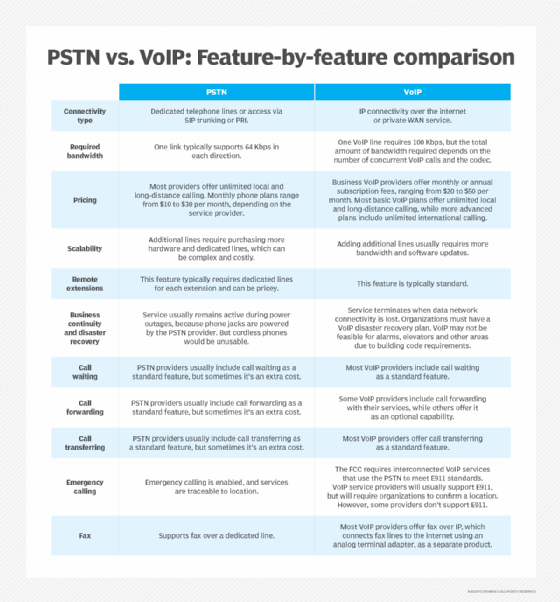What is PSTN (public switched telephone network)?
The public switched telephone network, or PSTN, is the world's collection of interconnected voice-oriented public telephone networks. PSTN is the traditional circuit-switched telephone network. PSTN comprises all the switched telephone networks around the world that are operated by local, national or international carriers. These networks provide the infrastructure and services for public telecommunication.
This is the system that has been in general use since the late 1800s. It's the aggregation of circuit-switching telephone networks that has evolved from the days of Alexander Graham Bell.
Using underground copper wires, this legacy platform has provided businesses and households alike with a reliable means to communicate with anyone around the world for generations. Today, it is almost entirely digital.
The phones themselves are known by several names, such as PSTN, landlines, Plain Old Telephone Service (POTS), or fixed-line telephones.
How does PSTN work?
A public switched telephone network is a combination of telephone networks used worldwide, including telephone lines, fiber optic cables, switching centers, cellular networks, satellites and cable systems. A PSTN lets users make landline telephone calls to one another.
A PSTN is made up of switches at centralized points on a network that function as nodes to enable communication between two points on the network. A call is placed after being routed through multiple switches. Voice signals can then travel over the connected phone lines.
The PSTN phone line is used with traditional dial-up network modems to connect a computer to the internet. Dial-up internet connections support up to 56 Kbps. In the early days of the internet, this was the main method for home internet access but it became obsolete with the introduction of broadband internet services.
PSTN architecture
The traditional PSTN has a hierarchical architecture and a star structure. The individual subscriber lines are connected to a local exchange, which communicates with trunk exchanges as well as main and central exchanges. The lines within a local exchange typically have the same area code. A user who wants to call a number outside the local exchange has to add an area code. To make an international call, a user has to dial the country code.
What's the difference between PSTN and ISDN?
Integrated Services Digital Network (ISDN) was developed for the digital transmission of data and voice over ordinary phone lines. ISDN provides better voice quality than PSTN. The ISDN provides 128 Kbps. One of the key features of the ISDN is it integrates both speech and data in the same line, which is not available with ordinary telephone wires. Users can make faster calls with ISDN than with PSTN.
What's the difference between PSTN and VoIP?
Voice over IP (VoIP), also known as IP telephony, broadband telephony or internet telephony, means voice communication is transmitted over the internet or private wide area network (WAN). VoIP eliminates the need for circuit-switched networks for phone calls.
VoIP uses codecs to turn audio into data packets, transmits them across an IP network and turns the packets back into audio on the receiving end of the call. Many organizations get their VoIP services from cloud unified communications providers, such as RingCentral and Vonage, or from VoIP providers, such as Grasshopper and Nextiva.
VoIP has advantages over PSTN, including lower network infrastructure costs, scalability and advanced features, such as unified communications and app integrations.

History of PSTN
The commercialization of telephones began in 1876. At that time, there were no network connections. Rather, telephones were wired in pairs for use between locations, which meant it wasn't possible to call more than one location. People who wanted to talk to people in different locations had to have several different telephones -- each with its own purpose. In the early days, operators connected one party of a phone call to another manually.
Telephone networks expanded in the 1900s as the number of people using telephones increased. This led to the growth of PSTN. Older telephone networks used analog signaling.
However, providers began to digitize voice calls by the 1960s and manual switching was replaced by automated electronic switching. This upgrade meant that digital voice signals could share the same wire with other phone calls.
Although most people associate the PSTN with copper wiring, modern PSTN infrastructure also uses fiber optic cables. Today, services have become increasingly digital, as new last-mile infrastructure -- such as fiber optic cables -- replaces copper lines.
Telecommunications providers are transitioning from PSTN to all-IP communications. The main reason is most carriers don't want to manage two infrastructures -- one with analog and one with digital equipment -- when just a digital architecture can offer the same or better level of service for customers.
In addition, manufacturers of telecom equipment are phasing out analog equipment in favor of digital equipment, making it increasingly difficult for carriers to maintain their analog infrastructures. Because digital technology can enable telecom operators to offer more services, they also prefer to invest in technology that may increase their revenue.







